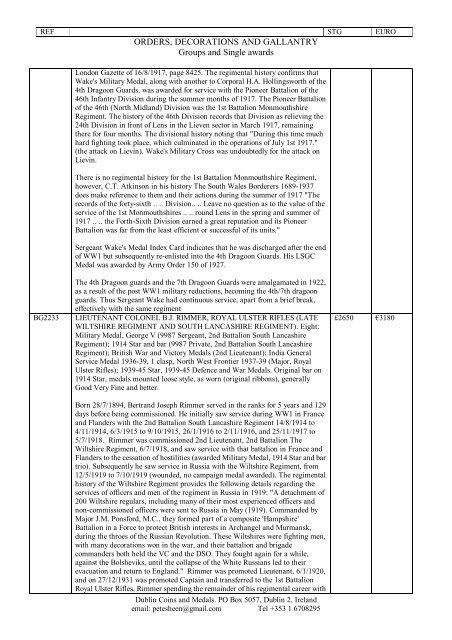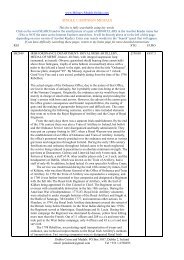ORDERS, DECORATIONS AND GALLANTRY Groups and Single ...
ORDERS, DECORATIONS AND GALLANTRY Groups and Single ...
ORDERS, DECORATIONS AND GALLANTRY Groups and Single ...
You also want an ePaper? Increase the reach of your titles
YUMPU automatically turns print PDFs into web optimized ePapers that Google loves.
REF STG EURO<br />
<strong>ORDERS</strong>, <strong>DECORATIONS</strong> <strong>AND</strong> <strong>GALLANTRY</strong><br />
<strong>Groups</strong> <strong>and</strong> <strong>Single</strong> awards<br />
London Gazette of 16/8/1917, page 8425. The regimental history confirms that<br />
Wake's Military Medal, along with another to Corporal H.A. Hollingsworth of the<br />
4th Dragoon Guards, was awarded for service with the Pioneer Battalion of the<br />
46th Infantry Division during the summer months of 1917. The Pioneer Battalion<br />
of the 46th (North Midl<strong>and</strong>) Division was the 1st Battalion Monmouthshire<br />
Regiment. The history of the 46th Division records that Division as relieving the<br />
24th Division in front of Lens in the Lieven sector in March 1917, remaining<br />
there for four months. The divisional history noting that "During this time much<br />
hard fighting took place, which culminated in the operations of July 1st 1917."<br />
(the attack on Lievin). Wake's Military Cross was undoubtedly for the attack on<br />
Lievin.<br />
There is no regimental history for the 1st Battalion Monmouthshire Regiment,<br />
however, C.T. Atkinson in his history The South Wales Borderers 1689-1937<br />
does make reference to them <strong>and</strong> their actions during the summer of 1917 "The<br />
records of the forty-sixth .. .. Division.. .. Leave no question as to the value of the<br />
service of the 1st Monmouthshires .. .. round Lens in the spring <strong>and</strong> summer of<br />
1917 .. .. the Forth-Sixth Division earned a great reputation <strong>and</strong> its Pioneer<br />
Battalion was far from the least efficient or successful of its units."<br />
Sergeant Wake's Medal Index Card indicates that he was discharged after the end<br />
of WW1 but subsequently re-enlisted into the 4th Dragoon Guards. His LSGC<br />
Medal was awarded by Army Order 150 of 1927.<br />
The 4th Dragoon guards <strong>and</strong> the 7th Dragoon Guards were amalgamated in 1922,<br />
as a result of the post WW1 military reductions, becoming the 4th/7th dragoon<br />
guards. Thus Sergeant Wake had continuous service, apart from a brief break,<br />
effectively with the same regiment<br />
BG2233 LIEUTENANT COLONEL B.J. RIMMER, ROYAL ULSTER RIFLES (LATE<br />
WILTSHIRE REGIMENT <strong>AND</strong> SOUTH LANCASHIRE REGIMENT). Eight:<br />
Military Medal, George V (9987 Sergeant, 2nd Battalion South Lancashire<br />
Regiment); 1914 Star <strong>and</strong> bar (9987 Private, 2nd Battalion South Lancashire<br />
Regiment); British War <strong>and</strong> Victory Medals (2nd Lieutenant); India General<br />
Service Medal 1936-39, 1 clasp, North West Frontier 1937-39 (Major, Royal<br />
Ulster Rifles); 1939-45 Star, 1939-45 Defence <strong>and</strong> War Medals. Original bar on<br />
1914 Star, medals mounted loose style, as worn (original ribbons), generally<br />
Good Very Fine <strong>and</strong> better.<br />
Born 28/7/1894, Bertr<strong>and</strong> Joseph Rimmer served in the ranks for 5 years <strong>and</strong> 129<br />
days before being commissioned. He initially saw service during WW1 in France<br />
<strong>and</strong> Fl<strong>and</strong>ers with the 2nd Battalion South Lancashire Regiment 14/8/1914 to<br />
4/11/1914, 6/3/1915 to 9/10/1915, 26/1/1916 to 2/11/1916, <strong>and</strong> 25/11/1917 to<br />
5/7/1918. Rimmer was commissioned 2nd Lieutenant, 2nd Battalion The<br />
Wiltshire Regiment, 6/7/1918, <strong>and</strong> saw service with that battalion in France <strong>and</strong><br />
Fl<strong>and</strong>ers to the cessation of hostilities (awarded Military Medal, 1914 Star <strong>and</strong> bar<br />
trio). Subsequently he saw service in Russia with the Wiltshire Regiment, from<br />
12/5/1919 to 7/10/1919 (wounded, no campaign medal awarded). The regimental<br />
history of the Wiltshire Regiment provides the following details regarding the<br />
services of officers <strong>and</strong> men of the regiment in Russia in 1919: "A detachment of<br />
200 Wiltshire regulars, including many of their most experienced officers <strong>and</strong><br />
non-commissioned officers were sent to Russia in May (1919). Comm<strong>and</strong>ed by<br />
Major J.M. Ponsford, M.C., they formed part of a composite 'Hampshire'<br />
Battalion in a Force to protect British interests in Archangel <strong>and</strong> Murmansk,<br />
during the throes of the Russian Revolution. These Wiltshires were fighting men,<br />
with many decorations won in the war, <strong>and</strong> their battalion <strong>and</strong> brigade<br />
comm<strong>and</strong>ers both held the VC <strong>and</strong> the DSO. They fought again for a while,<br />
against the Bolsheviks, until the collapse of the White Russians led to their<br />
evacuation <strong>and</strong> return to Engl<strong>and</strong>." Rimmer was promoted Lieutenant, 6/1/1920,<br />
<strong>and</strong> on 27/12/1931 was promoted Captain <strong>and</strong> transferred to the 1st Battalion<br />
Royal Ulster Rifles, Rimmer spending the remainder of his regimental career with<br />
Dublin Coins <strong>and</strong> Medals. PO Box 5057, Dublin 2, Irel<strong>and</strong><br />
email: petesheen@gmail.com Tel +353 1 6708295<br />
£2650 €3180



